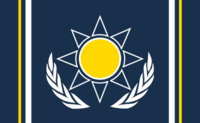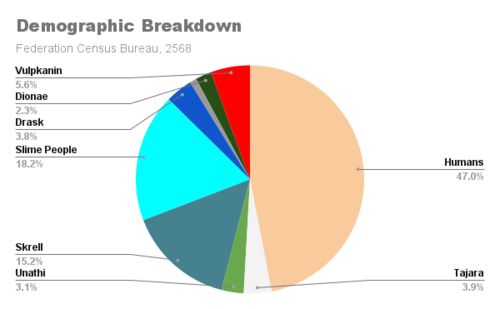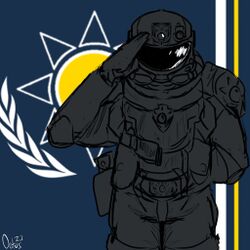Trans-Solar Federation


Assigned to:PopeDaveThe3th
Informal Names: TSF, SolGov, Feds
Capital: Earth, Sol System
Founding: July 14th, 2000
Residents: 87 billion est.
Languages: G. Common, Sol Common, Tradeband
Government: Stratocratic Controlled Democracy
Current Grand Marshal: Samantha R. Daud
Currency: Credit
Primary Exports: Consumer goods, foodstuffs, heavy machinery, armaments, ship hulls
Fleet: Ten active battlefleets. >1000 crewed warships. >1500 uncrewed droneships
The Trans-Solar Federation, also known as the TSF, SolGov, or simply the Federation, is the largest human-majority nation and de-facto superpower of the Orion Arm. Headquartered on Earth, the TSF is a unitary federal democracy in which only those who have performed a requisite five years of national service may vote or hold public office. Militaristic, assertive, and egalitarian, the Federation is a political chimera that has served as a bastion of capitalism and controlled liberty for centuries. With the strongest economy, industrial base, and armed forces in the known Sector, the TSF is a beacon of stability and power for all under its aegis.
Unfortunately, that stability may soon be relegated to the past. The Twilight Conflict against the USSP, having lasted centuries, appears to be drawing towards a conclusion with a whimper, as internal struggles force the Federation to withdraw much of its influence and strength abroad. Smaller nations which once chafed under Federal oversight now move to chart their own paths, many of which run contrary to Federation interests. Within the TSF itself, rampant expansionism has stretched its forces perilously thin, while bureaucratic bloat and corporate corruption sap its strength from within. Today, it is becoming increasingly clear to analysts and generals alike that the Federation’s greatest test yet may soon arrive. As to whether the sun will finally set, or if it will rise resurgent, none can yet say.
Abridged History 
Formation and Unification
Originating in the late 19th century, the Trans-Solar Federation (TSF) can trace its roots to the devastating Eastern Seas War, fought in the late 1990s following the invasion of Taiwan by the People’s Republic of China. As the war came to an end and the victorious forces of NATO and SATO returned home, the victory would prove pyrrhic as economic and political crises swept the world, resulting in widespread economic and social turmoil. To make the situation even worse, partisan gridlock and squabbling prevented the remaining nations from intervening effectively. It was apparent that extreme measures were needed to end the crisis, a view shared by the military forces of the alliances, which banded together under a cabal of top military officials. This cabal would force the creation of the nascent Solar Federation essentially at gunpoint during Operation Silver Throne, leading to the deadlock’s end and substantial power given to the Federation.
The Solar System and Beyond
Following the formation of the Solar Federation, humanity would quickly expand to colonize the Solar System under their direction, in waves of expeditions both private and government-funded. The discovery of a mineral called Plasma beneath the Martian soil would revolutionize space travel, with the first FTL-capable vessels breaching hyperspace in the mid 2000s. Rapid expansion would continue, now unconstrained by the speed of light, and the Federation would be renamed the Trans-Solar Federation (TSF) in respect to its new prospects. By the beginning of the 22nd Century, the Federation controlled a significant amount of territory in the Orion Arm, and had developed strong relations with the Skrell following a pleasant first contact. Unfortunately, the rest of the century would not pass nearly as smoothly, with the first of several hammerblows coming in 2113, as unprovoked attacks across the Frontier sparked the beginning of the Kidan War.
The Kidan War
While only lasting a year, the Kidan War remains the largest and most violent conflict in the Federation’s history. Millions perished across the frontier in the Kidan’s frenzied extermination campaign, with an equally high number of Kidan casualties as the insectoid race threw themselves into combat with no regard for self-preservation. After a year of bloody fighting, the war would be ended by a last-ditch decapitation strike on the Kidan home world of Aurum, with a joint battlegroup of Federation and Skrell warships fighting through the Kidan royal guards in a hail-Mary attack. The war would end in late 2115, as missile cruisers unleashed nuclear fire onto Aurum, killing the Kidan Empress and her successors. Even so, the problems were far from over, as the Cygni Crisis erupted near immediately afterward. Already plagued by internal unrest, the war taxes levied during and after the Kidan War would be the final straw, with full-scale revolution breaking out across Cygni and surrounding systems.
The Cygni Crisis & Rise of Nanotrasen
The Cygni Crisis remains the largest civil conflict in the Federation’s history. Originating in abuses of corporate power, and escalated by the rhetoric of cunning ideologue Malfoy Ames, the Crisis consisted of a mass socialist revolution in the Cygni system, along with more sporadic uprisings in neighbouring systems. A full Federation response was ordered following the brutal Oahu Massacre, in which over three thousand Federal personnel were murdered aboard the system’s TSF naval anchorage. The response fleet was under-strength from the Kidan War, however, and took severe damage en-route to Cygni III, though the rebel fleet was utterly annihilated. As Federation marines began to land, the ground war quickly became a quagmire, with horrific casualties on each side and severe damage levied onto Cygni III’s cities. The Crisis would end in late 2119 with a ceasefire agreement, with the USSP officially coming into existence shortly after, and absorbing most of the nearby systems who had similarly seceded during or after the rebellion. At the same time, the premier megacorporation Nanotrasen would prey on the weakened state of the Federation, beginning as series of corporate maneuvers that drastically increased its power, wealth, and influence, along with cementing it as an unassailable pillar of the Federal economy, safe from any retaliation.
Convention & Reform
Government & Politics
"The vast majority of our citizens don’t want grand revolutionary ideas or sweeping societal change. They want stability, safety, and a cause to believe in. The Federation will provide all three."
- Grand Marshal Bolan, regarding the TSF’s post-Cygni political reforms.While ostensibly representing all of its constituents equally, the Trans-Solar Federation is, in practice, a stratocratic federal democracy. Federal citizenship is only granted after a 3-year period of service in any branch of the Federal Armed Forces, or role as defined under the Federal Constitution. Those who have not completed this term, usually referred to as “residents” or “civilians”, are ineligible for most forms of political participation, and are excluded from several prominent government programs. The Federation operates with three primary branches of government: The Executive, represented by the Grand Marshal and their Executive Committee, the Legislative, represented by the Citizens’ Councils and the Civilian Assembly, and the Judicial, represented by the Federal Supreme Court. Below these are the five primary departments of the Federation, which in turn branch out into an unfathomable monolith of bureaus, sub-departments, and agencies responsible for keeping the Federation moving.
The Grand Marshal
The Joint Executive Committee
The Citizens' Councils
The Civilian Assembly
The Supreme Court
Political Divisions
Within the Federal system, power is divided between two entities, the central government based in Sol, and the various planets throughout the Federation’s vast territories. This division is mostly a matter of practicality, as the sheer size of the Federation’s territory and the massive distance between them makes any unitary state impossible. Planetary administrations may then internally divide power further into states or counties, which is encouraged by the Federal government as a planet grows in population. Generally, planetary governments mirror the organization of the Federal government, though some leeway is permitted within the bounds of the Federal Constitution.
Following the events of the Cygni Crisis and the subsequent constitutional convention, secession was officially disallowed under the Federal Constitution, and is considered high treason within the Federal court system.
Legal Status of AI
Artificial intelligence and cyborgs remain contentious topics within Federal space. While cyborg units made from the brains of organic citizens retain their legal rights and Citizenship, IPCs and positronic brains are not legally considered people, and thus cannot interact with much of Federal society.
The general stance of most Federation citizens towards IPC units is one of ambivalence. IPCs are uncommon within Federal space, usually only being seen as servants or assistants to the wealthy. As such, an IPC seen "in the wild" is far more likely to receive stares and pointed fingers than any form of outright violence.
Sector Authority Commands (SACs)
Sector Authority Commands represent the largest administrative division within the Federation, encompassing dozens, if not hundreds of systems. Every SAC is in and of itself a state in miniature, and most are at least somewhat self-sufficient. Each SAC also contains a number of Federation Navy battlefleets, usually two, which rotate between SACs.
SAC-Central
SAC-North
SAC-South
SAC-East
SAC-West
Military
"I solemnly swear that I will uphold and defend the virtues, ideals, and Constitution of the Trans-Solar Federation; that I will protect it against all foes foreign and domestic, known and alien; that to it I will give my complete and uncompromising allegiance; and that I will do my utmost to serve my nation and her people in all my duties. So I swear, without doubt, reservation, or intent of subversion, for Sol and the Federation."
- Federal Service Oath, Military Variant.Trans-Solar Marine Corps (TSMC)
The few, and the proud, the Trans-Solar Marine Corps is the scalpel to the Army’s hammer, and one of the most feared and effective fighting forces in the Orion sector. Numbering only around 500,000 active personnel, the TSMC is far smaller personnel-wise than the TSFN or Federal Army, but more than makes up for it in rigorous training, cutting-edge equipment, and a branch-wide commitment to being the greatest warriors in the Federation.
Where the Army is focused on taking and holding territory, the Marines instead specialize in rapid assault and maneuver, arriving to destroy their enemies with unstoppable swiftness and overwhelming firepower. The TSMC is additionally responsible for space-borne engagements, both conducting and repelling boarding operations. All ships in the Federation Navy of cruiser size and above carry a platoon or more of marines for this exact purpose.
"What stopped the Syndie plot? (Guns!) What was it the Reds forgot? (Guns!) What have we that they have not? (Big, big, guns!)."
- Drinking song of the Federation Navy.Built on nearly eight centuries of naval tradition, the Trans-Solar Federation Navy is one of, if not the strongest and most powerful space-faring navies in the sector, with the highest combined battle fleet tonnage of all known Sector powers, and the greatest number of active naval vessels, with ten active battlefleets each hosting approximately 200 ships of varying hull class. The TSFN is the largest branch of the Federal Armed Forces in terms of personnel, with approximately 2.5 million servicemembers on active duty, and ~500,000 in the Naval Reserves.
Federation Navy doctrine varies between battlefleets, but generally places heavy emphasis on big guns, long-range missiles, and large amounts of fighter and bomber squadrons, both manned and unmanned. Energy shields are uncommon in Federal vessels, as they are considered too power-inefficient for widespread use, with most ships instead relying on thick armor belts, overlapping point-defense grids, and electronic warfare suites. This results in most Federation warships having incredible offensive and defensive capabilities, but maneuverability that is sub-par at best for everything but specialized pursuit vessels.
Federation battlefleets tend to consist of around a dozen fleet and battlecarriers, escorted by a similar number of battleships, with both providing long-range fire and area denial. Cruiser and destroyer-class vessels make up the majority of a battlefleet, numbering around a hundred, weighted towards the destroyers. Cruisers represent the most variable class, counting missile boats, heavy line warships, and light pursuit ships among their number. Destroyer-class warships are commonly found as escort and point-defense vessels, providing cover for the larger ships in the flotilla. Frigate-class ships are less common, numbering around thirty, and perform the risky but important duties of pursuit and harassment, usually being attached in a squadron to a light cruiser to perform this duty. The remaining vessels in a battlegroup are logistics ships, including cargo vessels, fuel tankers, and marine assault ships, where applicable.
In recent decades, automated vessels have also begun to appear in Federation fleets with increasing regularity. Part of a Federation-wide effort to boost personnel and materiel on the frontiers, these new "droneships" often come in the hundreds within Federation battlefleets, occasionally outnumbering crewed vessels. Built en-masse in Federation orbital foundries, what these automated warships lack in quality, they more than make up for in numbers and reliability. These ships are usually seen only in frigate and destroyer hull sizes, with the first cruiser-class droneships having only recently entered full production. Crewed by non-sentient artifical intelligences or remotely piloted, droneships are considered highly expendable, and are most commonly used as picket vessels, CQB combatants, and logistics units.
Federal Army
Federation High Command (FEDHIGHCOMM)
Federation Combat Synthetics
Cyborgs and robots are a common sight within the Federal military, with both acting as specialized support for organic servicemembers. Of particular note is the distinction between “cyborg” and “robot”. The former is controlled by an organic brain, retains rank and rights, and does not have laws forced upon it, while robots are entirely synthetic and are lawed to ensure proper function. Cyborgs can be found in positions of authority just as often as their organic peers, with particular note going to Fleet Admiral Cruz, commander of the Sixth Battlefleet, and a cyborg who has faithfully served the Federation for nearly a century.
Cyborgs and androids can be commonly found within every branch of the Federal Armed Forces, though the exact nature of their shells tends to vary by branch. Navy cyborgs, not intended for combat, typically have lighter armor and additional tools over weaponry. Marine and Army cyborgs, on the other hand, feature additional armor plating and weaponry at the cost of speed.
Federation cyborg and android units use modules similarly to Nanotrasen synthetics, though Federation units come equipped with far more lethal options, even in rear echelon units. Generally, cyborg service members will have two shells at a time, a civilian shell for use when off-duty, and a militarized shell for use when on active, with the second shell being property of the Federation given its lethal capabilities.
The Federation Analytics and Intelligence Directorate (FAID)
"Knowledge is the friend of the righteous."
- Motto of the FAID.
The primary intelligence arm of the Federation, the center of its intelligence community, and an organization with seemingly limitless reach, FAID is a common boogeyman in the Orion Arm, and a source of paranoia and dread for any would threaten the Federation. Formed in the aftermath of the Cygni Crisis and Nanotrasen’s subsequent maneuvering, FAID is officially responsible for coordinating the Federation’s many smaller intelligence organs, as well as being the primary force behind operations and intel gathering beyond the Federation’s borders. Unofficially, the Directorate has a similar amount of influence within Federal space, and is believed responsible for countless instances of political interference, corporate sabotage, and even assassinations against those deemed dangerous by the Federation. Today, FAID is at the forefront of the TSF’s intelligence activities, furthering its reach across the sector, eliminating enemies of the Federation, and combatting intrusions from rival organizations.
Economy
The TSF possesses the largest economy of all known civilizations within the Orion Arm. While the total GDP of the Federation is difficult to calculate thanks to its size and interstellar distance, current estimates range between 200 - 350 trillion credits, with an average growth rate of 4.7%, though this varies heavily between systems and worlds. The nation’s currency, the Solar Credit, is the most commonly used in the Sector, and is backed by the Federal Reserve and the TSF’s mighty armies. The nation ranks first in nominal GDP and fourth in disposable income per capita.
The exact nature of the Federation’s economy depends on the planet in question. Highly developed habitable worlds such as Earth and Nova Byzantium are dominated by white-collar work and light industry, while barren worlds such as Ganymede and Chicomoztoc lean far more into heavy industry, fuel production, and other pollution-intensive work. The Federation also remains home to numerous major companies, including Nanotrasen, Cybersun Industries, and Sunburst Heavy Industries, among others. While some worlds have reached post-industrial levels of development, the Federation as a whole can be considered an industrial superpower, with the highest levels of raw production in the sector.
Earth itself remains the sector's premier financial center and remains one of the largest planetary economies within the Federation, second only to Mars in terms of financial movement. Earth is home to the Federation Stock Exchange, based in New York, and the corporate headquarters of several Federation-based companies, most notably Sunburst Heavy Industries.
Science, Technology, and Energy
Income and Wealth
Healthcare
International Trade
Currency and Central Bank
Demographics
While primarily human, the Federation’s egalitarian citizenship policies and predilection towards open borders and free trade has created a large and diverse society with every known race in the sector represented in some capacity. By the last Federal census, the Federation’s total population numbers in the high tens of billions. This number is heavily subject to change, however, as the rapid growth of the frontier and colonization of new worlds has led to a Federation-wide deployment of birth incentives to help populate these newly claimed systems and planets.
Population
Language
Immigration
Religion
Education
Culture & Society
"For the Federation, I will give my life."
- Unofficial Citizen motto.While most of the Federation’s worlds originates from an Earthen cultural group, the gradual expansion of humanity and the Federation’s unusual style of governance have created an overarching Federal culture not defined by birthplace or species, albeit with numerous planetary and provincial subgroups. This culture, often known as the Federal Creed, emphasizes duty, honorable conduct, personal courage, equality of opportunity and rights, and Federal pan-nationalism. The spread of this creed is also purposefully encouraged by the Federal government, who see it as a unifying force for the state, and a natural extension of the Federation’s ideals. Thanks to its massive population and numerous major companies, the Federation possesses significant cultural soft power.
While the Federal Creed may provide an overarching framework, the Federation itself can be more aptly described as a patchwork of numerous Earthly and alien cultures which flow and merge together across hundreds of worlds.
Foreign Relations
While the Federation retains excellent relations with the Skrell, its overall foreign policy is a far different story. Often decried as “overly militaristic”, “overbearing”, and “downright imperialist”, the Federation has historically maintained an expansion-heavy foreign policy, encouraging smaller states to join via political and economic pressure. While outright force is rare, this approach has borne fruit, and many smaller states within the frontier and beyond have been absorbed after seeing the benefits of cooperation or the futility of resistance. States which chose, or have been chosen, to join the Federation are integrated in stages, as previous offices and governmental systems are replaced with Federal equivalents.
Even so, most larger nations within the Orion Arm retain cordial relations with the Federation, as its vast market and production capabilities prove a boon to any willing to do business.


